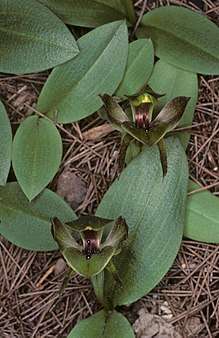Chiloglottis gunnii
Chiloglottis gunnii, commonly known as the tall bird orchid,[2] is a species of orchid endemic to Tasmania. It has two broad leaves and a single green to purplish brown flower with a line of erect calli with swollen heads along the mid-line of the labellum. It is widespread but mainly in coastal districts and most commonly in moist to wet forest.
| Tall bird orchid | |
|---|---|
 | |
| Scientific classification | |
| Kingdom: | Plantae |
| Clade: | Tracheophytes |
| Clade: | Angiosperms |
| Clade: | Monocots |
| Order: | Asparagales |
| Family: | Orchidaceae |
| Subfamily: | Orchidoideae |
| Tribe: | Diurideae |
| Genus: | Chiloglottis |
| Species: | C. gunnii |
| Binomial name | |
| Chiloglottis gunnii | |
| Synonyms[1] | |
Description
Chiloglottis gunnii is a terrestrial, perennial, deciduous, herb with two leaves 40–60 mm (1.6–2.4 in) long and 15–20 mm (0.6–0.8 in) wide. A single green to purplish brown flower 20–24 mm (0.79–0.94 in) long and 20–25 mm (0.8–1 in) wide is borne on a flowering stem 60–100 mm (2–4 in) high. The dorsal sepal is egg-shaped to spatula-shaped with the narrower end towards the base, 20–24 mm (0.8–0.9 in) long and 7–11 mm (0.3–0.4 in) wide. The lateral sepals are linear to lance-shaped, 15–20 mm (0.6–0.8 in) long, about 2 mm (0.08 in) wide and taper towards their tips. There is a glandular tip 0.5–1.5 mm (0.02–0.06 in) long on the end of all three sepals. The petals are lance-shaped but curved, 15–17 mm (0.6–0.7 in) long, 4.5–6 mm (0.18–0.24 in) wide and spread widely apart from each other. The labellum is broadly egg-shaped to heart-shaped, 10–13 mm (0.4–0.5 in) long and 10–15 mm (0.4–0.6 in) wide with a line of pillar-like calli about 3 mm (0.1 in) high with large swollen heads up to 2 mm (0.08 in) wide. The column is 15–18 mm (0.6–0.7 in) long and 5–6 mm (0.20–0.24 in) wide and curved with narrow wings.[2][3]
Taxonomy and naming
Chiloglottis gunnii was first formally described in 1840 by John Lindley and the description was published in his book The Genera and Species of Orchidaceous Plants.[4][5] The specific epithet (gunnii) honours Ronald Campbell Gunn, who collected the type specimen which was sent to William Jackson Hooker who forwarded it to Lindley.[5][6]
Distribution and habitat
The tall bird orchid is widespread but uncommon, growing mostly in wet forest and coastal scrub.[2][3]
References
- "Chiloglottis gunnii". World Checklist of Selected Plant Families (WCSP). Royal Botanic Gardens, Kew.
- Jones, David L. (2006). A complete guide to native orchids of Australia including the island territories. Frenchs Forest, N.S.W.: New Holland. p. 144. ISBN 1877069124.
- Jones, David L. (1998). "Contributions to Tasmanian Orchidology". Australian Orchid Research. 3: 64–65.
- "Chiloglottis gunnii". APNI. Retrieved 20 April 2018.
- Lindley, John (1840). The Genera and Species of Orchidaceous Plants. London: Ridgways. p. 387. Retrieved 21 April 2018.
- "Gunn, Ronald Campbell (1808 - 1881)". Australian National Botanic Garden. Retrieved 21 April 2018.
External links

